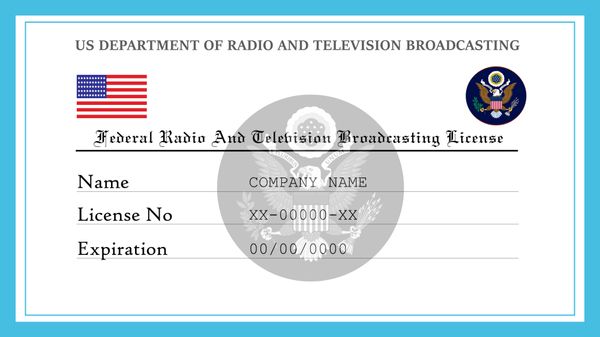
Federal Radio and Television Broadcasting License
Radio and television candidates should be aware that frequencies for these services are in high demand all of the time. Candidates fill competing applications when the application filing window for new stations opens. It is not a guarantee that you will get a broadcast station building permit if you submit an application. In many parts of the nation, there may be no frequencies available on which a new station may start broadcasting without interfering with existing stations, which would be a violation of Federal Communications Commission (FCC) guidelines. As a result, we do not suggest purchasing any equipment until you have received building permission from the FCC.
Operation without a license is illegal
The most frequent question is if broadcasting at extremely low power requires a license. Remember that operating radio broadcast stations without a license are illegal, even at low power levels such as 1 watt or less. On the AM and FM broadcast bands, Part 15 of the FCC’s rules governing the sole unlicensed activity which has a limit to a coverage radius of around 200 feet. In television bands, an unlicensed operation is illegal. The unauthorized running of an unlicensed station may result in fines and criminal punishment.
Forms for the Federal Communications Commission (FCC)
You can use FCC application forms to assist in the preparation of data for an application, but please note that you must submit all forms online. Besides all the electronic documents there is also a “paper” or PDF form. The Media Bureau Electronic Filing page has a list of broadcast application forms that are accessible for electronic filing.
AM Radio Broadcast Stations
Stations that broadcast on AM. Stations that broadcast on AM on frequencies ranging from 540 to 1700 kHz. These stations have the basis of non-interference. An application for this station must demonstrate that no interference will be on the other US and international AM stations on the same frequency. According to 47 CFR Section 73.182, applications must additionally include the second harmonic frequency and intermediate frequency relationships (s). Broadcast engineering experts are best to undertake these sophisticated technical studies since they need specific expertise and software.
Rules
AM station rules are found in 47 CFR 73.1 through 73.190, as well as 73.1001 through 73.5009.
Application Filing Fee, Form to Use
New AM radio station construction permit applications must be submitted electronically on FCC Form 301 during a specific application window time. FCC Form 301 should also be used by noncommercial educational applicants. With the fee payment and application, commercial applicants must submit the new station application filing fee specified in the Media Bureau Fee Filing Guide, as well as FCC Form 159.
Not Online payments for business applications you must send to the lockbox location rather than the FCC in Washington, D.C.
Procedures and Deadlines of Auction 109: AM, and FM Commercial Allotments.
FM Commercial Radio Broadcast Stations
From 92.1 MHz to 107.9 MHz, which corresponds to Channels 221 through 300, FM commercial stations may be allowed. Noncommercial educational FM stations may be allowed in this band, but they must fulfill the same spacing, city coverage of 70 dBu, and other technical requirements as commercial stations.
Rules
47 CFR 73.201 through 73.333, as well as 73.1001 through 73.5009, FM commercial station rules
Making a Request for a New
Allotment To apply for a new allotment, an applicant/petitioner must:
- Fill out and submit FCC Form 301, Application for Construction Permit, for the petitioner’s requested allocation. You must completely fill out and approve this application. With the fee payment and application, the applicant must pay the rulemaking fee as well as the application filing charge stated in the Media Bureau Fee Filing Guide, as well as FCC Form 159. Payments for business applications not submitted online you must send to the lockbox address, not the FCC in Washington, D.C., as stated above.
- File a petition for regulation on letter-sized paper (an original and two copies) through the Office of the Secretary, FCC, on the same day when you submit Form 301. The proposed new allotment site must meet the spacing requirements of 47 CFR Section 73.207 of the Commission’s rules to other stations, prior-filed applications, and vacant allotments, and (3) the proposed new allotment site must provide at least a 70 dBu signal strength across the whole community.
Low Power FM (LPFM) Noncommercial Educational Radio Broadcast Stations
Low-power FM (LPFM) stations have a range of 1 to 100 watts of power and may reach a radius of up to 5.6 kilometers (3.5 miles). On the LPFM page, you may find up-to-date information on the low-power FM filing service.
Costs of construction
The Federal Communications Commission (FCC) does not collect information on the expenses of building and equipment for nonprofit educational FM stations. The National Telecommunications and Information Administration (NTIA) offers a list of average expenditures for noncommercial educational FM stations on their Public Telecommunications Facilities Program website.
Costs may differ significantly from those stated. Applicants and potential applicants should not buy equipment until they have received a building permit from the FCC, since they may not be able to use or resale it if their application is denied.
Useful Forms
New LPFM station applications you can submit online on FCC Form 318 during the application filing window dates. Applications received at other times will be ignored and returned. We are unable to offer an estimate of when the next application filing window will open. But when that information will appear, it will be in the form of a Public Notice and will be available on the FCC’s website in many locations.
FM Translators and Boosters
Existing AM and FM broadcasts connect to local regions via FM translator stations. FM translators rebroadcasting commercial stations must keep on frequencies between 92.1 MHz and 107.9 MHz, whereas noncommercial educational FM translators may use any frequency. It is illegal for translator stations to broadcast content that the originating or primary station is not broadcasting at the same time.
Rules
47 CFR 74.1 through 73.34, as well as 47 CFR 74.1201 through 73.1290, are the FM Translator and Booster regulations.
Useful Forms and Fees for Filing an Application
TO use the FCC Form 345 for translator stations you should apply for this sort of FM station. The submission of all applications for translators is electronic. With the fee payment and application, commercial applicants must submit the new station application filing fee specified in the Media Bureau
Fee Filing Guide, as well as FCC Form 159
There is no application filing fee for non-commercial applicants. Competing applications will be auctioned off, with the highest bidder getting the allotments construction permit.
Full Power Television Stations
Full-power television stations in the United States use a Table of Allotments for allot. Parties interested in launching a new fully functional television station must first petition the FCC to designate a new channel for a specific community. If the board approves your application, the Commission will hold an auction filing window during which interested parties can submit an application to participate in the new channel’s auction.
Rules
47 CFR 73.601 to 73.699, as well as 47 CFR 73.1001 to 73.5009, cover television rules.
Costs of construction
The FCC does not collect information on television station construction and equipment expenses. On its Public Telecommunications Facilities Program website, the NTIA offers a list of average expenditures for nonprofit educational (public) television stations, however, that information is years old. Costs may differ significantly from those stated. Applicants and potential applicants should not buy equipment until they have received a building permit from the FCC. Since they may not be able to use or resale it if their application is denied.
Low Power Television (LPTV) stations, TV Translator Stations, and Class A Television Stations
On Channels 14 through 36, a low-power television station broadcasts with less than 150 kW of power, or 3 kW on Channels 2 through 13. An LPTV station can transmit content that is not broadcast by any other television station. A television translator station rebroadcasts programs from another television station rather than producing its own. By July 31, 2021, television translator and low-power television (LPTV) stations must switch from analog to digital operation.
Rules
47 CFR 74.1 through 74.34, as well as 47 CFR 74.701 through 74.797, cover LPTV and television translator rules.
Useful Forms, Filing Window
Interested parties will be notified of an application filing window (through Public Notice) during which they can submit applications for new digital LPTV or television translator stations. When filing, applicants will need to use the Media Bureau’s Licensing and Management System (LMS) Form 2100, Schedule C.
Buying an Existing Station
If you’re thinking about buying a radio or television station, you should first speak with the station’s present owner. The FCC doesn’t retain a list of stations that could be for sale. And it doesn’t engage in any sales contract talks. We don’t keep track of station owners’ phone numbers or e-mail addresses because they frequently change.
Useful Forms
After you’ve discovered a station for sale and signed a contract to buy it. You must electronically complete FCC Form 314 with the proper application filing fee within 30 days. Applicants who apply to buy a station may not take over operations until the FCC authorizes the acquisition application. The buyer must submit a letter of consummation within 90 days after receiving the grant if the application is accepted. Within 90 days of receiving the award, you must submit FCC Form 323 or FCC Form 323-E. When a new organization or an individual gets a controlling block of shares in the broadcasting business, you must fill an FCC Form 315.
